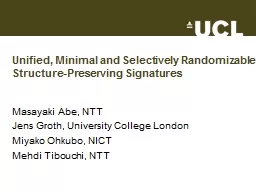PPT-Unified, Minimal and Selectively Randomizable Structure-Pre
Author : liane-varnes | Published Date : 2016-04-10
Masayaki Abe NTT Jens Groth University College London Miyako Ohkubo NICT Mehdi Tibouchi NTT Unified Minimal Small signatures and low verification complexity Single
Presentation Embed Code
Download Presentation
Download Presentation The PPT/PDF document "Unified, Minimal and Selectively Randomi..." is the property of its rightful owner. Permission is granted to download and print the materials on this website for personal, non-commercial use only, and to display it on your personal computer provided you do not modify the materials and that you retain all copyright notices contained in the materials. By downloading content from our website, you accept the terms of this agreement.
Unified, Minimal and Selectively Randomizable Structure-Pre: Transcript
Download Rules Of Document
"Unified, Minimal and Selectively Randomizable Structure-Pre"The content belongs to its owner. You may download and print it for personal use, without modification, and keep all copyright notices. By downloading, you agree to these terms.
Related Documents














